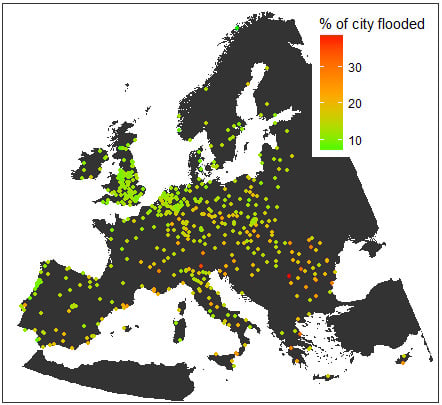Pluvial Flooding in European Cities—A Continental Approach to Urban Flood Modelling
Abstract
:1. Introduction
- the quality of the available DEMs, especially in forested regions and urban areas where the satellite information might correspond to the top of the canopy/building instead of the elevation of the ground;
- the quality of the precipitation data, which is very variable in time and place, and the fact that different types of rainfall inputs (gauge, radar, satellite or reanalysis) results in different orders of magnitude in terms of monetary loss from flooding results;
- the lack of data to calibrate hydrological models, especially in ungauged catchments.
2. Data
- EU-DEM [8]—a Digital Elevation Model over Europe “produced using Copernicus data and information funded by the European Union”. The EU-DEM is a hybrid product based on SRTM and ASTER GDEM data with 25-m resolution (projection 3035: EU-DEM-3035).
- Urban Morphological zones 2000 [10] defined as “set of urban areas laying less than 200 m apart”. This European Environment Agency (EEA) dataset was built based on the urban land cover classes of the CORINE Land Cover dataset. This data was necessary to define the “urban area” inside each city since the definition of “city” in the urban audit dataset can include non-urban areas, and sometimes even estuaries (see Figure S2 in Supplementary Materials for some examples).
- E-obs [11], an European daily gridded data set for precipitation and maximum and mean surface temperature at a 0.25 degree resolution for the period 1950–2013. E-obs is based on observations from 2316 stations, although the number changes over time showing a sharp rise in the number of gauges from 1950 to 1960 and a dip in 1976 (for stations with less than 20% missing monthly data). However, the spatial coverage throughout Europe is every uneven, with the UK, Ireland, the Netherlands and Switzerland having a much higher gauge density.
- Several observed sub-daily rainfall datasets were combined:
- -
- A total of 38 European gauges with time-series of annual maximum hourly rainfall, provided by Dr Panos Panagos, from the Joint Research Centre, that were collected under the auspices of the REDES project [12].
- -
- Some 192 UK gauges with time-series of annual maximum hourly rainfall (provided by Dr. Stephen Blenkinsop from Newcastle University) that were collected under the auspices of the CONVEX project [13]. These data were collected from three sources: the UK Met Office Integrated Data Archive System (MIDAS), the Scottish Environmental Protection Agency (SEPA) and the UK Environment Agency (EA). Not all these gauges were used, since that would mean the density of gauges used in the UK would be well above the density of gauges in the rest of Europe, therefore affecting the results of the analyses.
- -
- One gauge (Catraia) with hourly time-series for the South of Portugal downloaded from the Portuguese National Water Resources Information System (http://snirh.pt/).
- -
- IDF curves were collated for:
3. Methods
3.1. Historical Intense Hourly Rainfall
3.2. Urban Hydrodynamic Model
4. Results and Discussion
5. Conclusions
Supplementary Materials
Acknowledgments
Author Contributions
Conflicts of Interest
References
- Glenis, V.; McGough, A.S.; Kutija, V.; Kilsby, C.; Woodman, S. Flood modelling for cities using cloud computing. J. Cloud Comput. 2013, 2, 7. [Google Scholar] [CrossRef]
- Smith, A.; Sampson, C.; Bates, P. Regional flood frequency analysis at the global scale. Water Resour. Res. 2015, 51, 539–553. [Google Scholar] [CrossRef]
- Hijmans, R.J.; Cameron, S.E.; Parra, J.L.; Jones, P.G.; Jarvis, A. Very high resolution interpolated climate surfaces for global land areas. Int. J. Climatol. 2005, 25, 1965–1978. [Google Scholar] [CrossRef]
- Sampson, C.C.; Smith, A.M.; Bates, P.D.; Neal, J.C.; Alfieri, L.; Freer, J.E. A high-resolution global flood hazard model. Water Resour. Res. 2015, 51, 7358–7381. [Google Scholar] [CrossRef] [PubMed]
- Van der Knijff, J.M.; Younis, J.; de Roo, A.P.J. Lisflood: A gis-based distributed model for river basin scale water balance and flood simulation. Int. J. Geogr. Inf. Sci. 2010, 24, 189–212. [Google Scholar] [CrossRef]
- Rojas, R.; Feyen, L.; Bianchi, A.; Dosio, A. Assessment of future flood hazard in Europe using a large ensemble of bias-corrected regional climate simulations. J. Geophys. Res. Atmos. 2012, 117. [Google Scholar] [CrossRef]
- Roudier, P.; Andersson, J.C.M.; Donnelly, C.; Feyen, L.; Greuell, W.; Ludwig, F. Projections of future floods and hydrological droughts in europe under a +2 °C global warming. Clim. Chang. 2016, 135, 341–355. [Google Scholar] [CrossRef]
- European Environment Agency (EEA). Digital Elevation Model over Europe (EU-DEM). Available online: http://www.eea.europa.eu/data-and-maps/data/eu-dem (accessed on 12 December 2014).
- Geodatabase URAU_2004; GISCO Urban Audit, European Commission, Eurostat: Luxembourg, 2004.
- European Environment Agency (EEA). Urban Morphological Zones 2000. Available online: http://www.eea.europa.eu/data-and-maps/data/urban-morphological-zones-2000-2 (accessed on 18 June 2014).
- European Climate Assessment & Dataset (ECAD). E-Obs Data Portal. Available online: http://www.ecad.eu/download/ensembles/download.php (accessed on 25 November 2013).
- Panagos, P.; Ballabio, C.; Borrelli, P.; Meusburger, K.; Klik, A.; Rousseva, S.; Tadić, M.P.; Michaelides, S.; Hrabalíková, M.; Olsen, P.; et al. Rainfall erosivity in Europe. Sci. Total Environ. 2015, 511, 801–814. [Google Scholar] [CrossRef] [PubMed]
- Blenkinsop, S.; Lewis, E.; Chan, S.C.; Fowler, H.J. Quality control of an hourly precipitation dataset and climatology of extremes for the UK. Clim. Chang. 2017, 37, 722–740. [Google Scholar]
- Koutsoyiannis, D.; Baloutsos, G. Analysis of a long record of annual maximum rainfall in athens, greece, and design rainfall inferences. Nat. Hazards 2000, 22, 29–48. [Google Scholar] [CrossRef]
- Ayuso-Muñoz, J.L.; García-Marín, A.P.; Ayuso-Ruiz, P.; Estévez, J.; Pizarro-Tapia, R.; Taguas, E.V. A more efficient rainfall intensity-duration-frequency relationship by using an “at-site” regional frequency analysis: Application at Mediterranean climate locations. Water Resour. Manag. 2015, 29, 3243–3263. [Google Scholar] [CrossRef]
- Pérez-Zanón, N.; Casas-Castillo, M.C.; Rodríguez-Solà, R.; Peña, J.; Rius, A.; Solé, J.G.; Redaño, Á. Analysis of extreme rainfall in the Ebre observatory (Spain). Theor. Appl. Climato. 2016, 124, 935–944. [Google Scholar] [CrossRef]
- Hailegeorgis, T.T.; Thorolfsson, S.T.; Alfredsen, K. Regional frequency analysis of extreme precipitation with consideration of uncertainties to update IDF curves for the city of Trondheim. J. Hydrol. 2013, 498, 305–318. [Google Scholar] [CrossRef]
- Willems, P. Multidecadal oscillatory behaviour of rainfall extremes in Europe. Clim. Chang. 2013, 120, 931–944. [Google Scholar] [CrossRef]
- Faulkner, D. Rainfall frequency estimation. In Flood Estimation Handbook; Institute of Hydrology: Lancaster, UK, 1999. [Google Scholar]
- Lambert, D.; Argence, S. Preliminary study of an intense rainfall episode in Corsica, 14 September 2006. Adv. Geosci. 2008, 16, 125–129. [Google Scholar] [CrossRef]
- Harten, A.; Lax, P.D.; van Leer, B. On upstream differencing and godunov-type schemes for hyperbolic conservation laws. SIAM Rev. 1983, 25, 35–61. [Google Scholar] [CrossRef]
- Godunov, S.K. Finite difference method for numerical computation of discontinuous solutions of the equations of fluid dynamics. Mat. Sb. 1959, 47, 271–306. [Google Scholar]
- Toro, E.F. Riemann Solvers and Numerical Methods for Fluid Dynamics: A Practical Introduction; Springer: Berlin, Germany, 2013. [Google Scholar]
- Osher, S.; Solomon, F. Upwind difference schemes for hyperbolic conservation laws. Math. Comput. 1982, 38, 339–374. [Google Scholar] [CrossRef]
- Schubert, J.E.; Sanders, B.F.; Smith, M.J.; Wright, N.G. Unstructured mesh generation and landcover-based resistance for hydrodynamic modeling of urban flooding. Adv. Water Resour. 2008, 31, 1603–1621. [Google Scholar] [CrossRef]
- Kutílek, M.; Nielsen, D.R. Soil Hydrology; Catena Verlag: Cremlingen, Germany, 1994. [Google Scholar]
- Environment Agency (UK). What Is the Updated Flood Map for Surface Water? Environment Agency: Bristol, UK, 2013; Available online: https://www.gov.uk/government/uploads/system/uploads/attachment_data/file/297432/LIT_8988_0bf634.pdf (accessed on 5 April 2017).
- Sitzenfrei, R.; Möderl, M.; Rauch, W. Assessing the impact of transitions from centralised to decentralised water solutions on existing infrastructures—Integrated city-scale analysis with vibe. Water Res. 2013, 47, 7251–7263. [Google Scholar] [CrossRef] [PubMed]
- Institute of Hydrology. Flood Estimation Handbook, Volume 3: Statistical Procedures for Flood Frequency Estimation; Institute of Hydrology: Wallingford, UK, 1999. [Google Scholar]
- Ochoa-Rodriguez, S.; Wang, L.-P.; Gires, A.; Pina, R.D.; Reinoso-Rondinel, R.; Bruni, G.; Ichiba, A.; Gaitan, S.; Cristiano, E.; van Assel, J.; et al. Impact of spatial and temporal resolution of rainfall inputs on urban hydrodynamic modelling outputs: A multi-catchment investigation. J. Hydrol. 2015, 531, 389–407. [Google Scholar] [CrossRef]
- Gires, A.; Giangola-Murzyn, A.; Abbes, J.-B.; Tchiguirinskaia, I.; Schertzer, D.; Lovejoy, S. Impacts of small scale rainfall variability in urban areas: A case study with 1D and 1D/2D hydrological models in a multifractal framework. Urban Water J. 2015, 12, 607–617. [Google Scholar] [CrossRef]
- Berne, A.; Delrieu, G.; Creutin, J.-D.; Obled, C. Temporal and spatial resolution of rainfall measurements required for urban hydrology. J.Hydrol. 2004, 299, 166–179. [Google Scholar] [CrossRef]
- Blanc, J.; Hall, J.W.; Roche, N.; Dawson, R.J.; Cesses, Y.; Burton, A.; Kilsby, C.G. Enhanced efficiency of pluvial flood risk estimation in urban areas using spatial—Temporal rainfall simulations. J. Flood Risk Manag. 2012, 5, 143–152. [Google Scholar] [CrossRef]
- Burton, A.; Glenis, V.; Bovolo, C.I.; Blenkinsop, S.; Fowler, H.J.; Chen, A.S.; Djordjevic, S.; Kilsby, C.G. Stochastic rainfall modelling for the assessment of urban flood hazard in a changing climate. In Proceedings of the British Hydrological Society’s Third International Symposium, Newcastle, UK, 19–23 July 2010; pp. 39–45. [Google Scholar]
- VanKirk, D.J. Vehicular Accident Investigation and Reconstruction; CRC Press: Boca Raton, FL, USA, 2000. [Google Scholar]
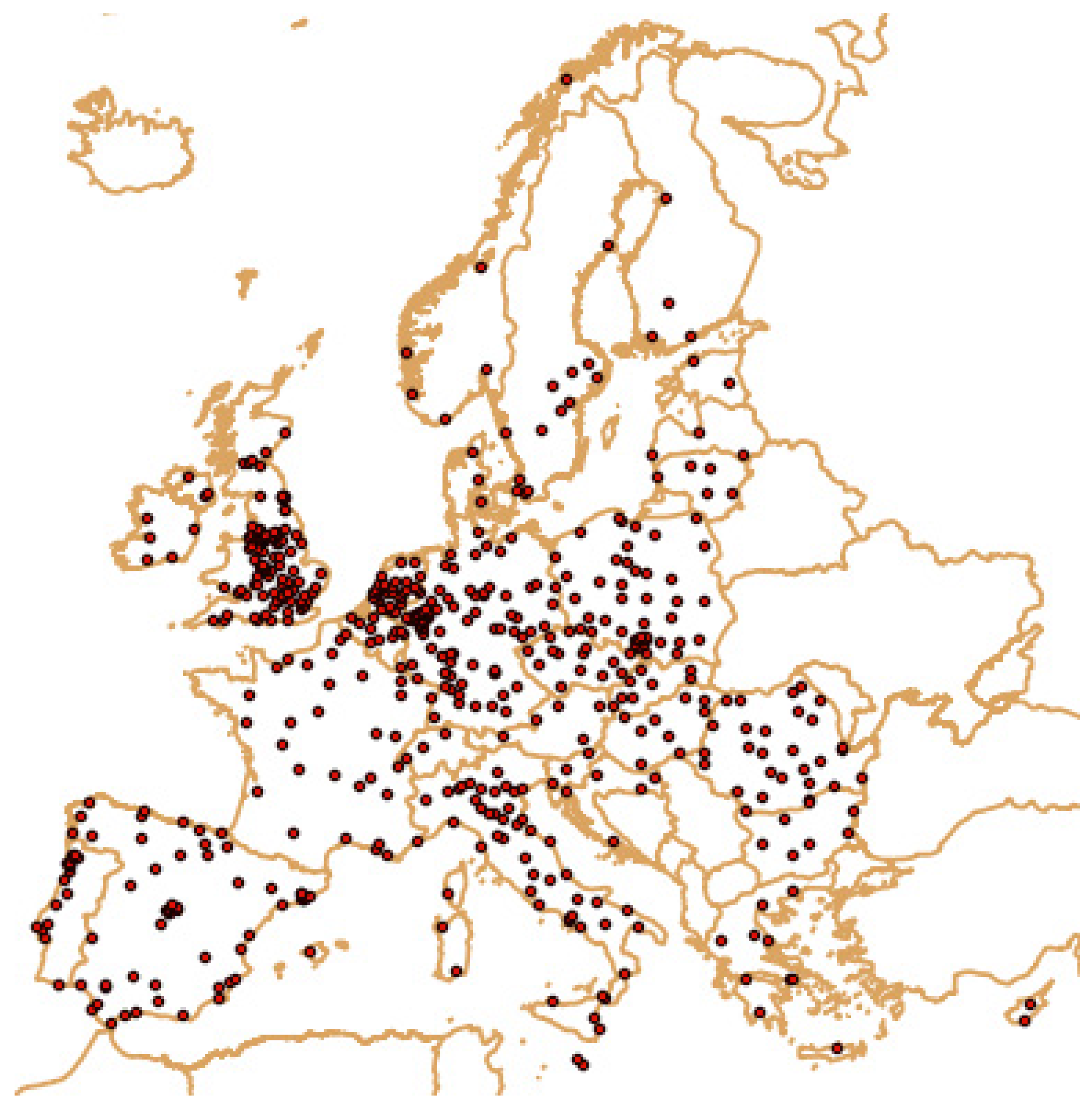
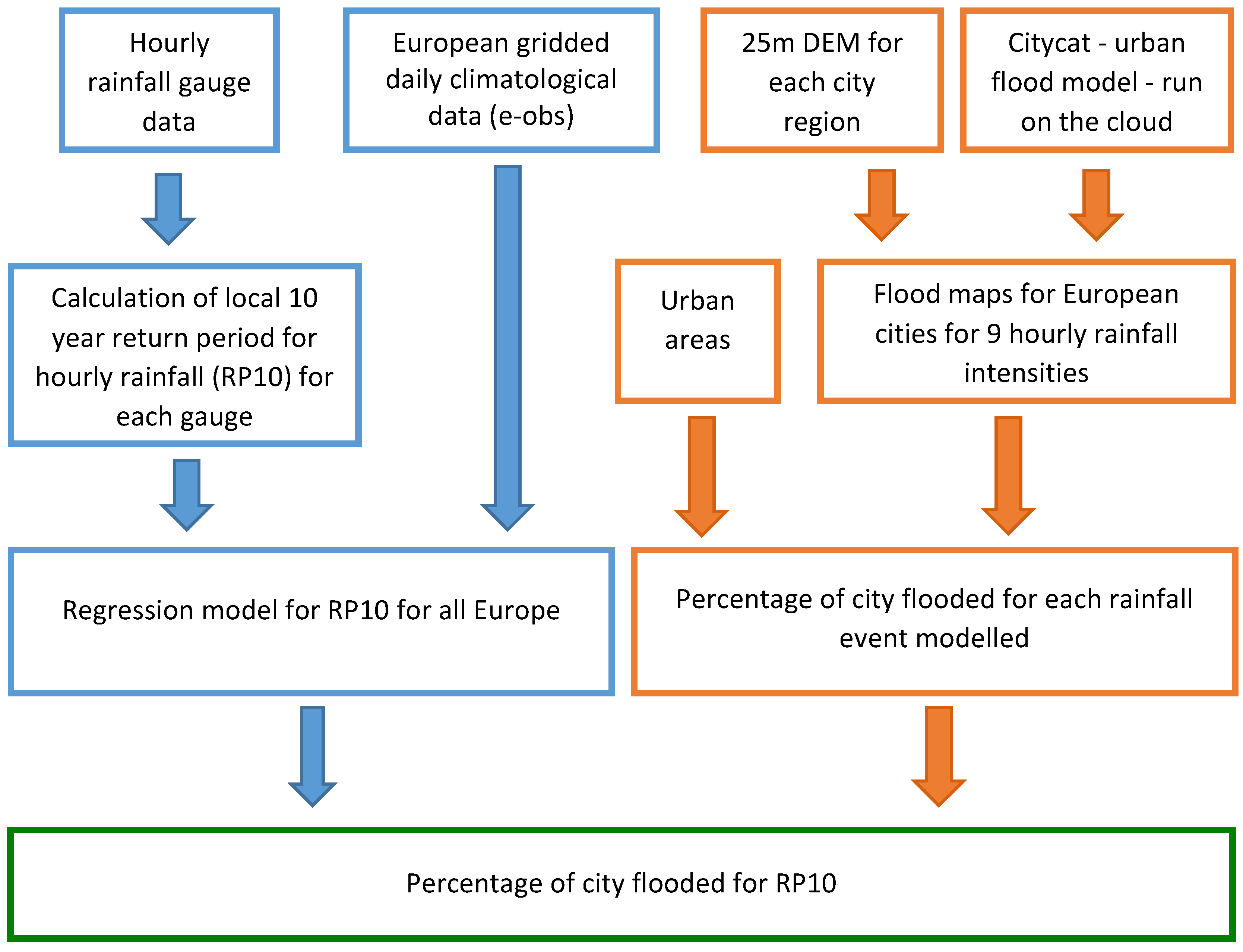
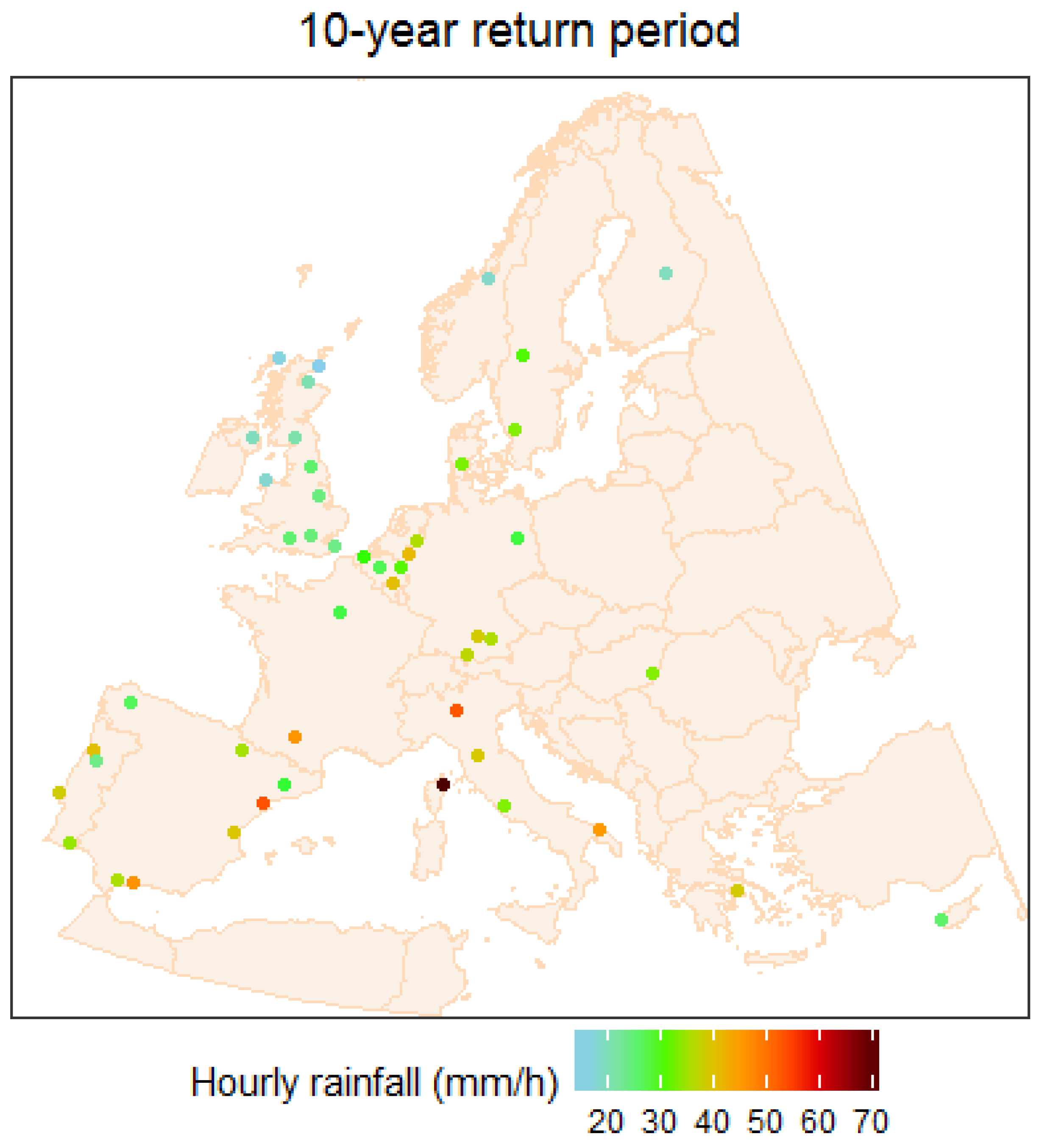
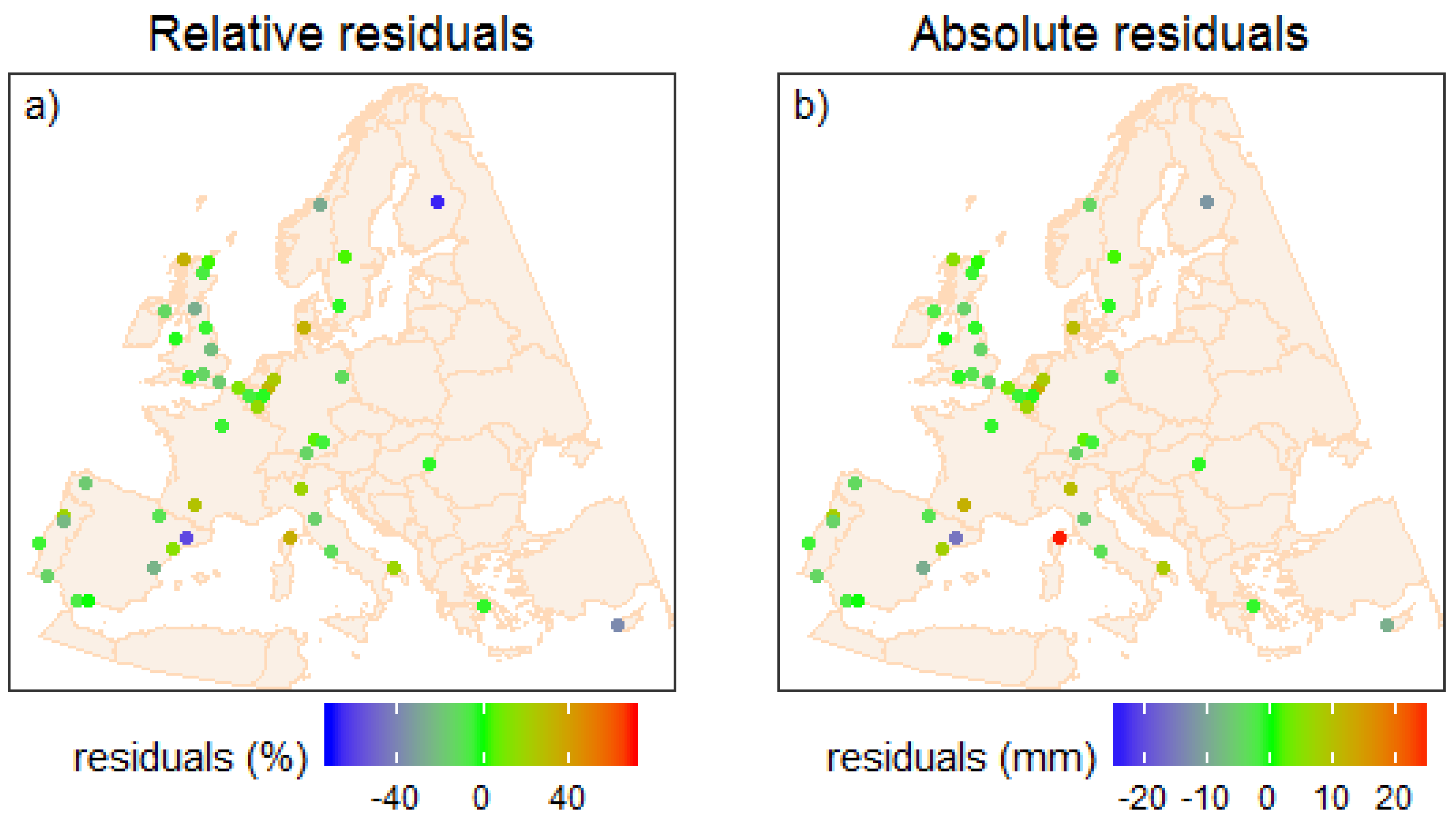
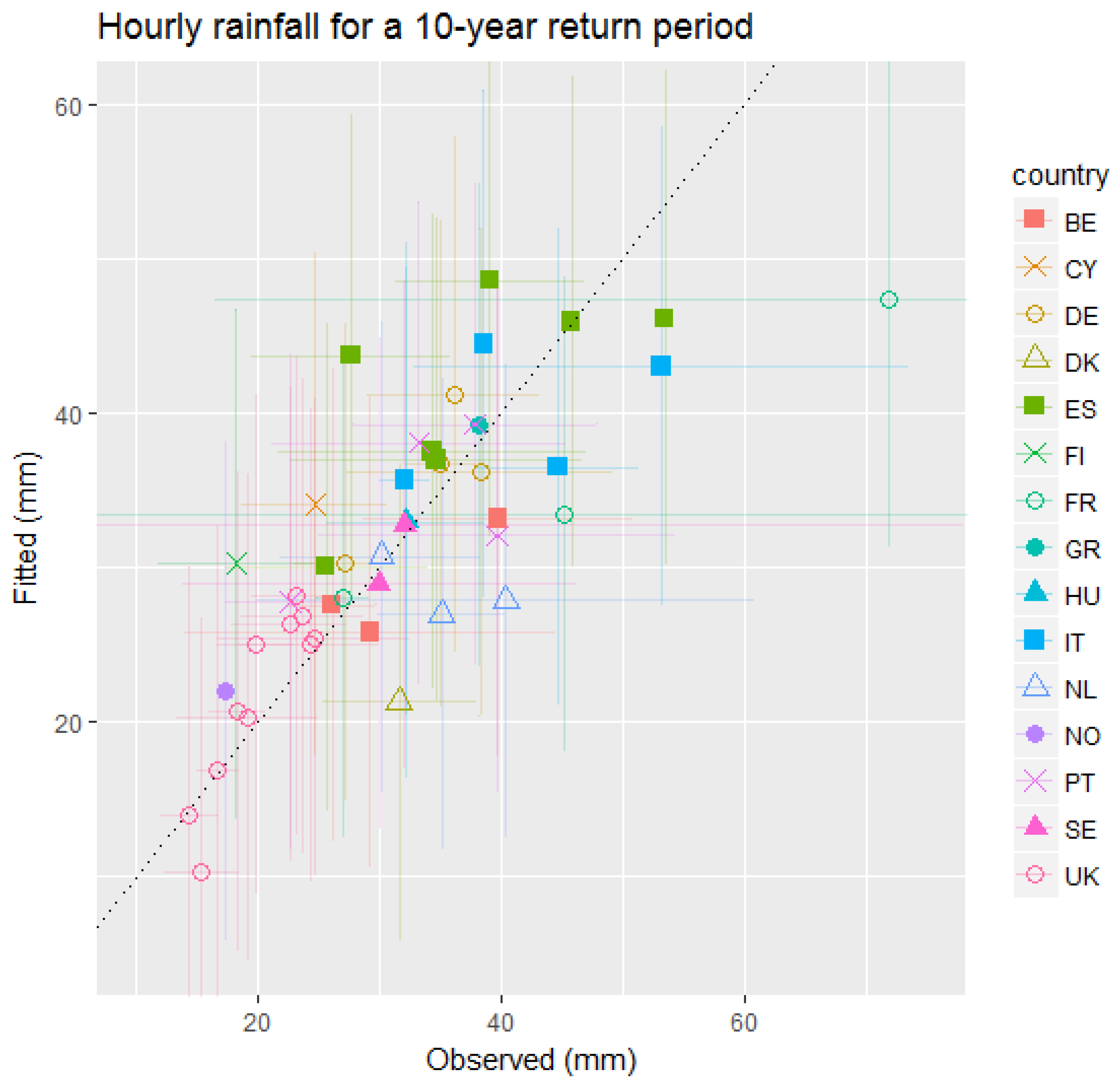
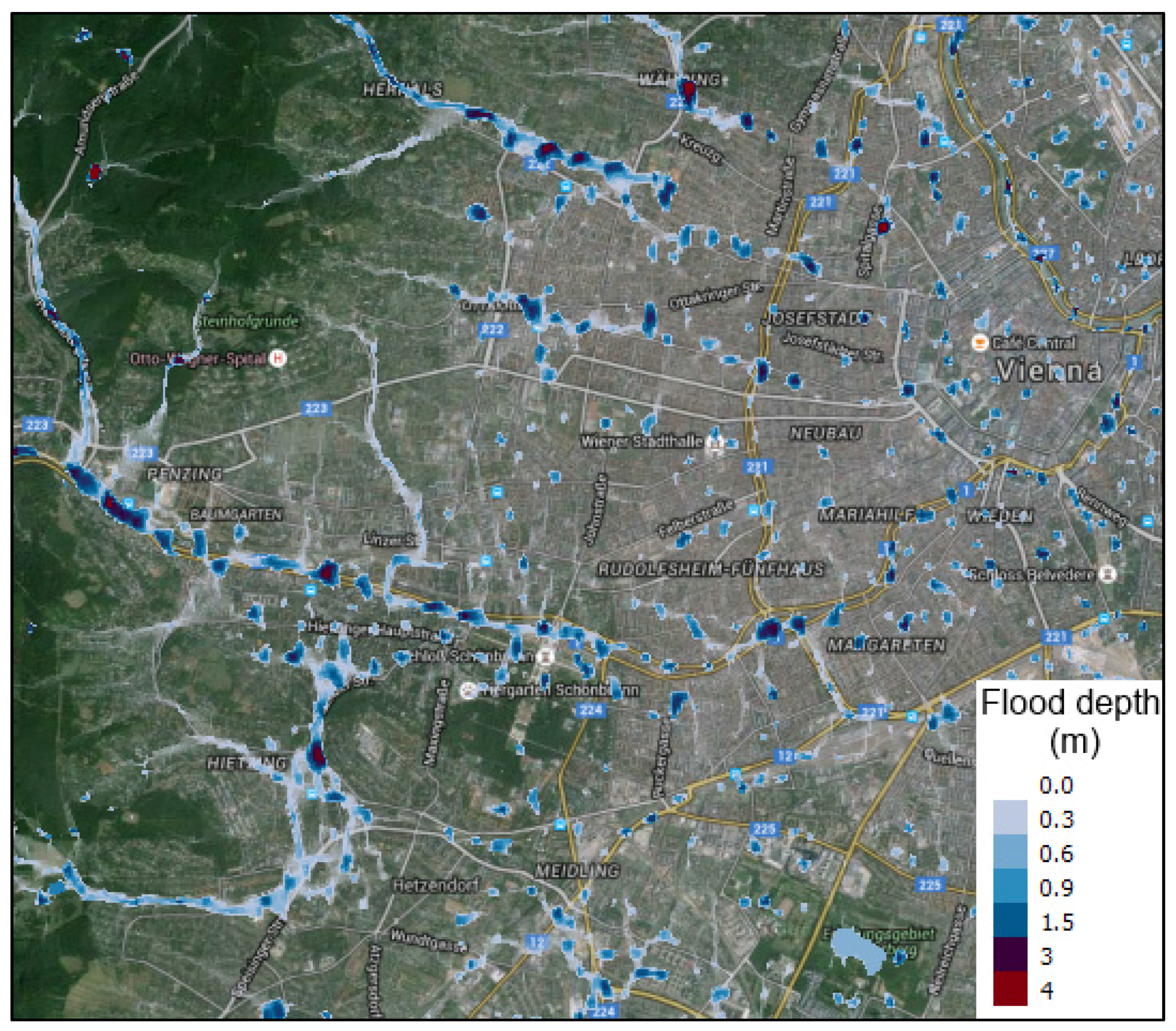
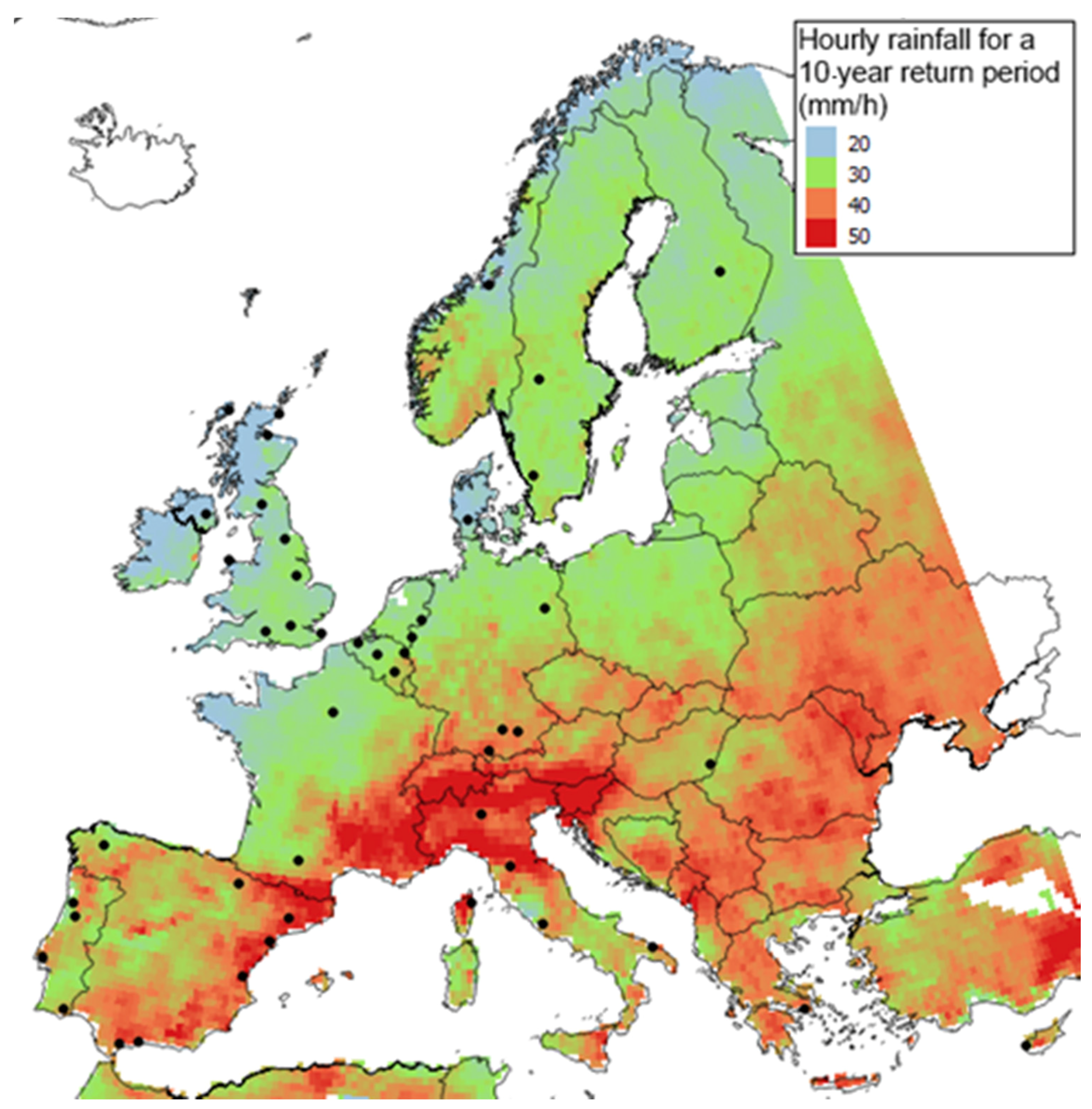

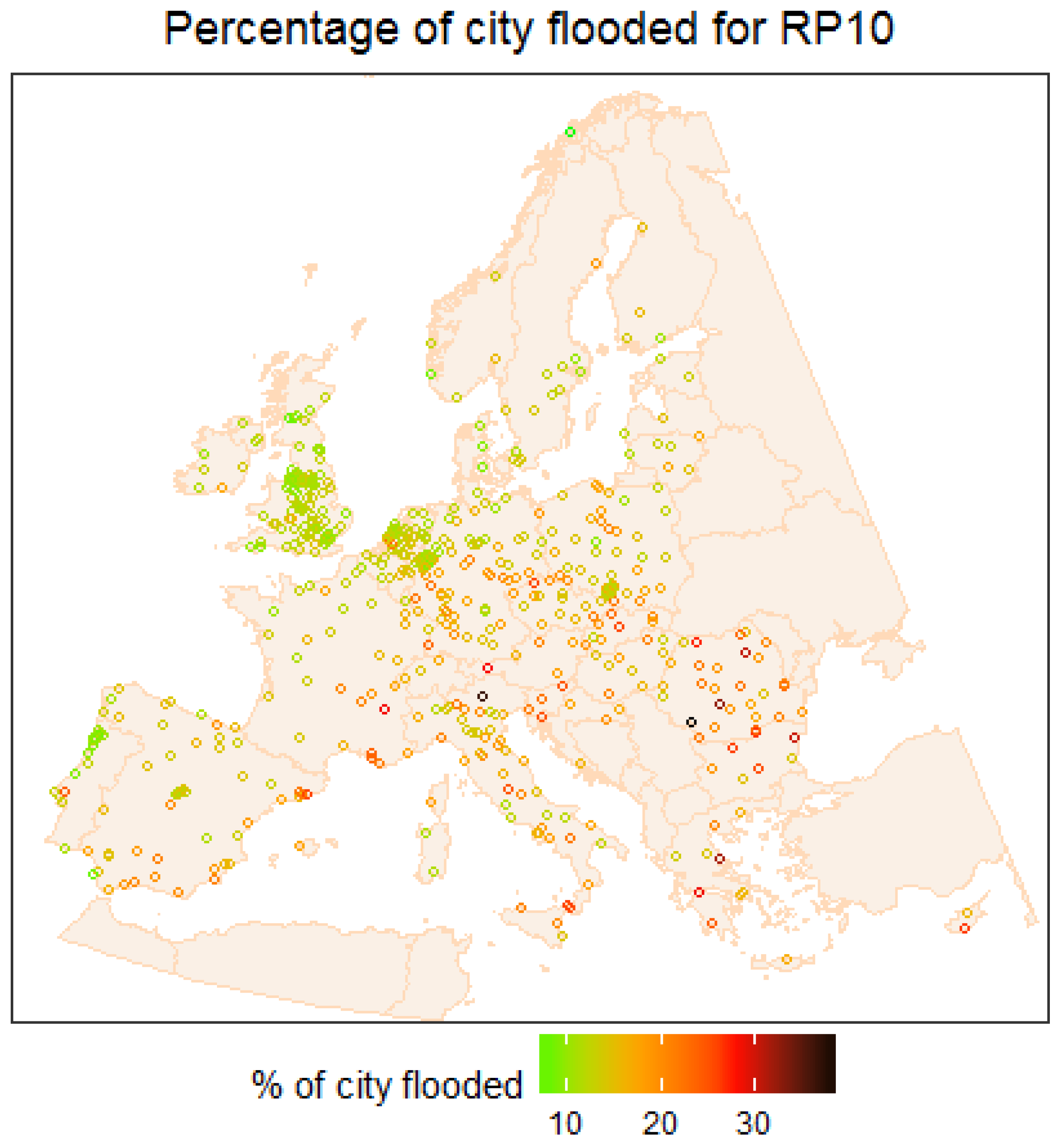
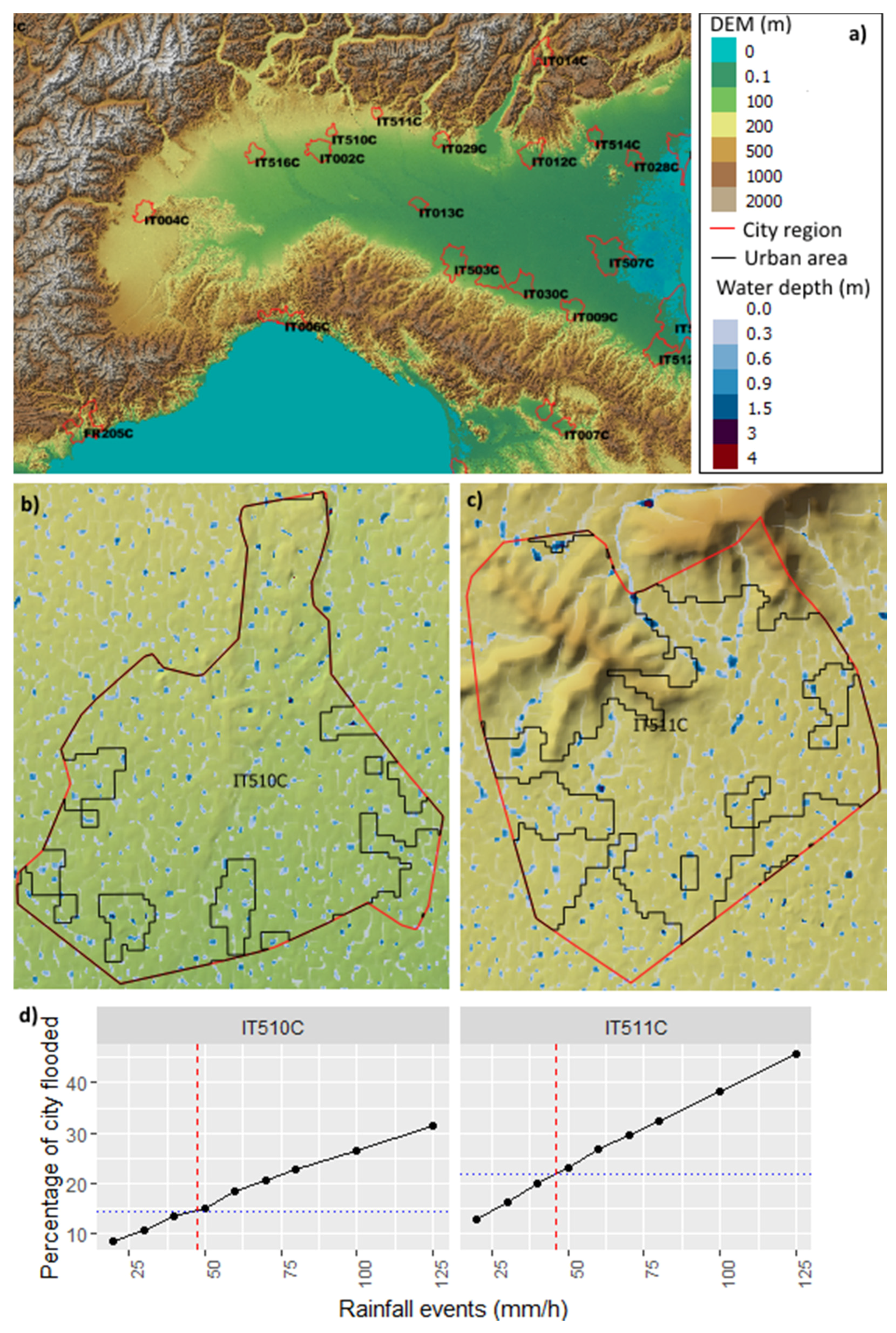
© 2017 by the authors. Licensee MDPI, Basel, Switzerland. This article is an open access article distributed under the terms and conditions of the Creative Commons Attribution (CC BY) license (http://creativecommons.org/licenses/by/4.0/).
Share and Cite
Guerreiro, S.B.; Glenis, V.; Dawson, R.J.; Kilsby, C. Pluvial Flooding in European Cities—A Continental Approach to Urban Flood Modelling. Water 2017, 9, 296. https://doi.org/10.3390/w9040296
Guerreiro SB, Glenis V, Dawson RJ, Kilsby C. Pluvial Flooding in European Cities—A Continental Approach to Urban Flood Modelling. Water. 2017; 9(4):296. https://doi.org/10.3390/w9040296
Chicago/Turabian StyleGuerreiro, Selma B., Vassilis Glenis, Richard J. Dawson, and Chris Kilsby. 2017. "Pluvial Flooding in European Cities—A Continental Approach to Urban Flood Modelling" Water 9, no. 4: 296. https://doi.org/10.3390/w9040296






